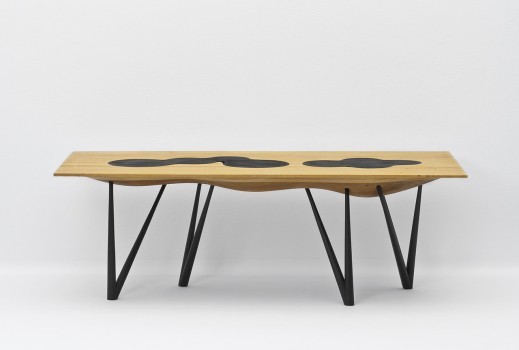Greg Lynn
Secret Table
17 May - 11 Jun 2017

Secret Table, 2008. Design: Greg Lynn
Producer: Studio Lynn, University of Applied Arts / MAK, Vienna
Material: Alder, oak, partly stained. MAK H 3403. Donation by Greg Lynn, Los Angeles, USA
Producer: Studio Lynn, University of Applied Arts / MAK, Vienna
Material: Alder, oak, partly stained. MAK H 3403. Donation by Greg Lynn, Los Angeles, USA
GREG LYNN
Secret Table
17 May 2017 – 11 Jun 2017
Curator: Sebastian Hackenschmidt, Curator, MAK Furniture and Woodwork Collection
Since about the mid-1980s, designers have developed an innovative yet difficult to define repertoire of forms for a whole range of everyday things from toothbrushes to motorbikes. The seemingly organic objects with their flowing, curvaceous forms are collectively known as “blobjects”—a portmanteau word made up of “blob” and “object.” The advent of blobjects, which in the 1980s playfully subverted the traditional repertoire of forms and created opportunities for rejuvenating aesthetics, was inextricably linked with computer-aided design. As an attempt to create autonomous, unpredictable forms—untrammeled by significance and outside the realm of traditional aesthetics—through an automated, rationalized design process, the blobjects pioneered the exploration of formlessness.
As architect and designer, Greg Lynn was an early pioneer in the systematic application of computers to create “methodical” deviations from customary patterns and stereotypes. In his design process, he incorporated computational errors—usually automatically suppressed by programming functions—to develop forms not traceable to classic geometry, enabling him to integrate expansive “formless” convexities—so-called “blebs” or bubbles—into the surface continuities of his designs.
“Blebs are pockets of space formed when a surface intersects itself making a captured space. Most computer software has automatic loop cutting functions that eliminate these elements from surfaces. Blebs were discovered in the office because the loop cutting invariably compromised the rigor of the surface geometry and the rhythmic pattern of panels and control vertices. By turning off the loop cutting function we discovered miniature volumes rippling across the surfaces we were designing.” (Greg Lynn: Form, ed. by Bruce Q. Lan, Beijing 2006, p. 24)
When in 2008 the MAK presented its FORMLESS FURNITURE exhibition—focusing for the first time on various aspects and examples of formlessness in furniture design—in cooperation with Studio Lynn at the University of Applied Arts Vienna, Greg Lynn offered to create for the exhibition an object that he had been planning for some time: the Secret Table. The rectangular tabletop of this piece of furniture provides, as it were, the predefined structure in—and under—which computer-generated curvilinear, convex blob shapes are able to unfold. The dimensions of the “secret” bulges on the table’s underside are so designed that they function as “spatial pockets,” concealing cavities let into the tabletop that can be closed off and used to store provisions or tableware. The Secret Table is presented here for the first time together with two models that were created in 2007 in the Greg Lynn FORM architecture studio in Los Angeles and donated to the MAK in 2012.
Secret Table
17 May 2017 – 11 Jun 2017
Curator: Sebastian Hackenschmidt, Curator, MAK Furniture and Woodwork Collection
Since about the mid-1980s, designers have developed an innovative yet difficult to define repertoire of forms for a whole range of everyday things from toothbrushes to motorbikes. The seemingly organic objects with their flowing, curvaceous forms are collectively known as “blobjects”—a portmanteau word made up of “blob” and “object.” The advent of blobjects, which in the 1980s playfully subverted the traditional repertoire of forms and created opportunities for rejuvenating aesthetics, was inextricably linked with computer-aided design. As an attempt to create autonomous, unpredictable forms—untrammeled by significance and outside the realm of traditional aesthetics—through an automated, rationalized design process, the blobjects pioneered the exploration of formlessness.
As architect and designer, Greg Lynn was an early pioneer in the systematic application of computers to create “methodical” deviations from customary patterns and stereotypes. In his design process, he incorporated computational errors—usually automatically suppressed by programming functions—to develop forms not traceable to classic geometry, enabling him to integrate expansive “formless” convexities—so-called “blebs” or bubbles—into the surface continuities of his designs.
“Blebs are pockets of space formed when a surface intersects itself making a captured space. Most computer software has automatic loop cutting functions that eliminate these elements from surfaces. Blebs were discovered in the office because the loop cutting invariably compromised the rigor of the surface geometry and the rhythmic pattern of panels and control vertices. By turning off the loop cutting function we discovered miniature volumes rippling across the surfaces we were designing.” (Greg Lynn: Form, ed. by Bruce Q. Lan, Beijing 2006, p. 24)
When in 2008 the MAK presented its FORMLESS FURNITURE exhibition—focusing for the first time on various aspects and examples of formlessness in furniture design—in cooperation with Studio Lynn at the University of Applied Arts Vienna, Greg Lynn offered to create for the exhibition an object that he had been planning for some time: the Secret Table. The rectangular tabletop of this piece of furniture provides, as it were, the predefined structure in—and under—which computer-generated curvilinear, convex blob shapes are able to unfold. The dimensions of the “secret” bulges on the table’s underside are so designed that they function as “spatial pockets,” concealing cavities let into the tabletop that can be closed off and used to store provisions or tableware. The Secret Table is presented here for the first time together with two models that were created in 2007 in the Greg Lynn FORM architecture studio in Los Angeles and donated to the MAK in 2012.


